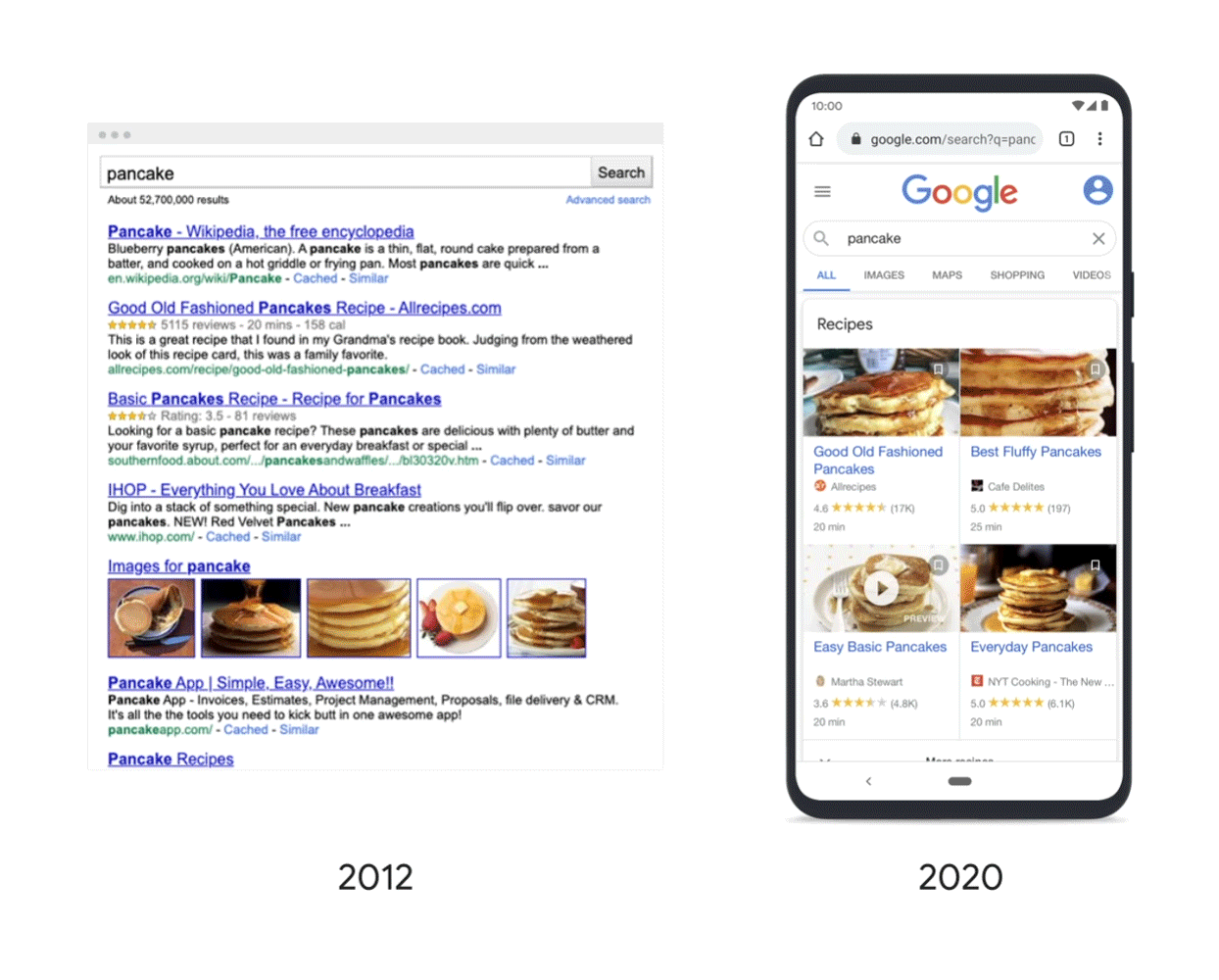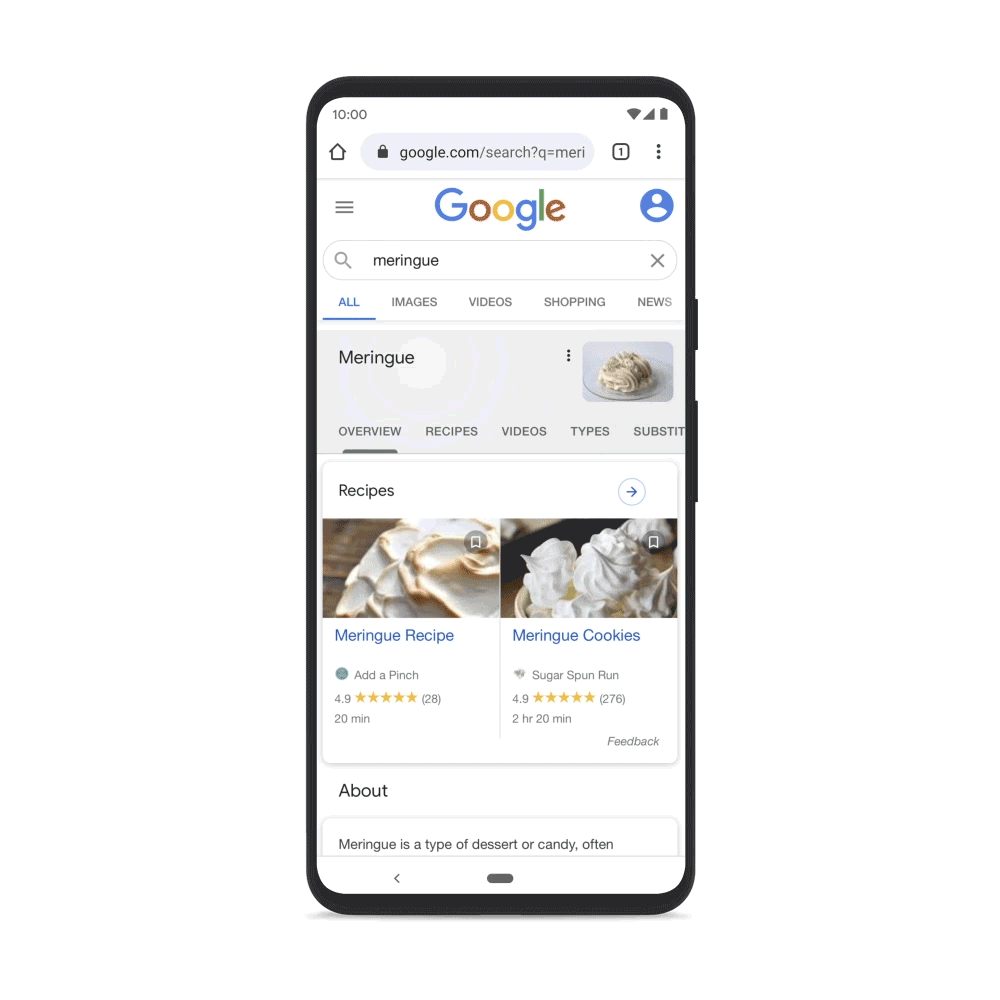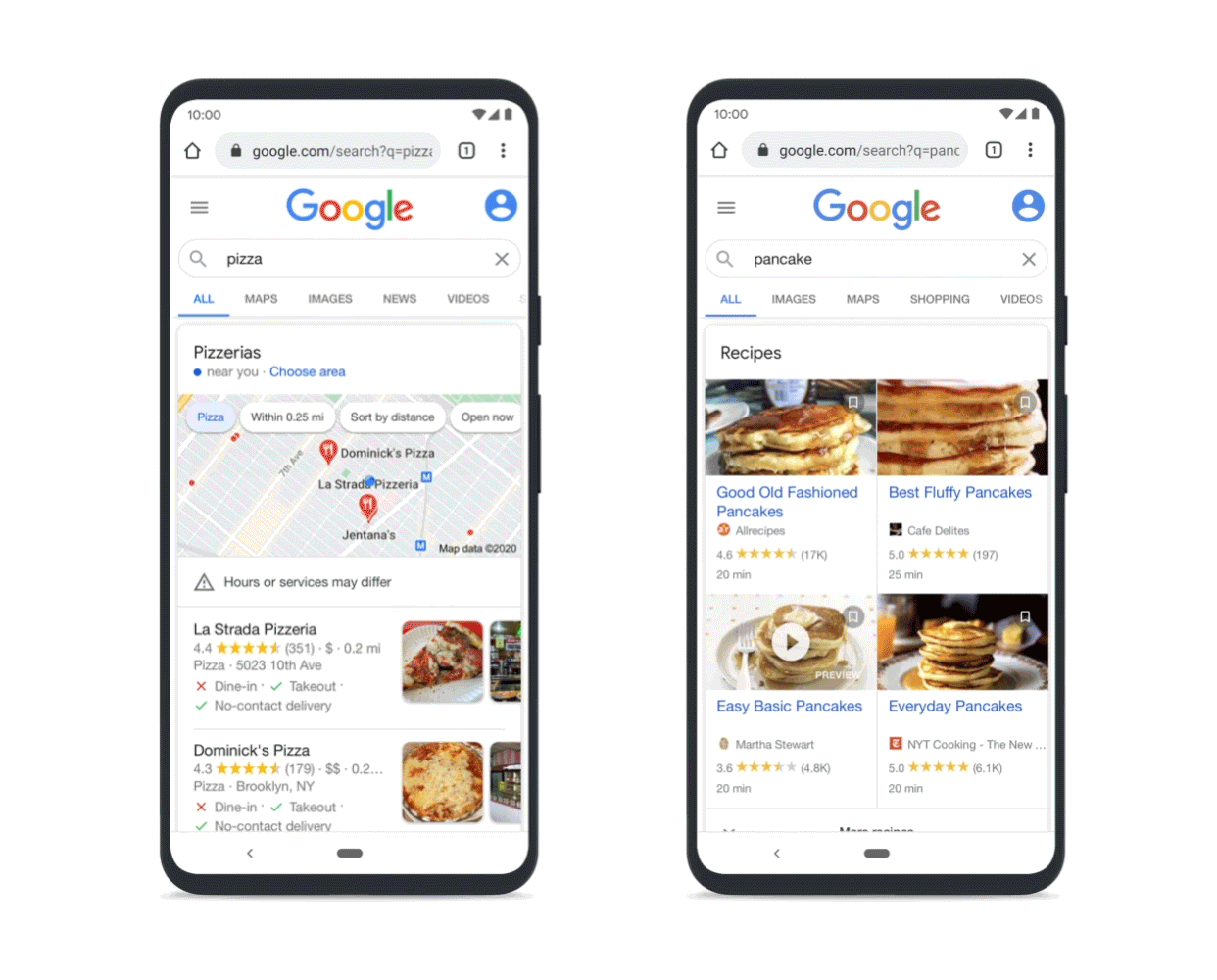Google Search, how info are organized and displayed
Google continues its transparency operations, with which it tries to inform (summarily) users and experts about the operation of its search engine: with the latest contribution, we can find out how is organized the famous Search Index, where the information comes from and how the algorithm manages to make SERPs useful, responding to requests from people and respecting the criteria and priorities set by Google.
The Google Index and info for users
The biggest challenge of Google today is not only indexing everything that is available on the Web, but also (and most importantly) presenting the results in a useful and quickly accessible way to users, organizing the information it shows in SERP in an easy to understand and “digest” for people.
For this reason, Nick Fox (Vice President of Product & Design, Search and Assistant of the American company) has tried to offer “a closer look at how we approach the organization of information on Google Search”with two different articles published on the official Google website.
When you come to Google and launch a search, Fox says, “there could be billions of pages that are potential matches for your query and millions of new pages are produced every minute”. At first, Google updated its search index once a month but now “like other search engines, we constantly index new information to make it accessible via search”.
The complexity of the work of the search engine
A further element of complexity comes from Google’s ambitions that, since its foundation more than 22 years ago, has continued “to pursue the mission of organizing worldwide information and making it universally accessible and useful”. A broader objective than the simple organization of web pages, which rather concerns the organization of “all the information in the world”, as Fox says.
In a short time, the VP continues, “Google expanded beyond the Web and began looking for new ways to understand the world and make information and knowledge accessible to more people. The Internet and the world have changed a lot since those early days and we continued to improve Google Search to anticipate and respond to the evolving information needs of people”.
It is no mystery that “the results of the research you saw in 1998 are different from those you might find today”, and it therefore requires a disclosure effort by the company to give some quick details on “how we approach the organization of an ever-expanding universe of web pages, images, videos, insights into the real world and all the other forms of information that there may be”.
Google’s ambitions
Today, in fact, Google “indexes all types of information, from text and images in web pages to real-world information, like if a local store has in stock a sweater you are looking for”.
To make this amount of data useful, Google “arranges them in the search results page so as to make them easy to scan and digest: when looking for a job, you often want to view a list of specific roles, while if you’re looking for a restaurant, see a map can help you easily find a place nearby”.
With its continuous evolution, SERPs currently offer “a wide range of functions – from video and news carousels to results enriched with images, from useful labels such as star reviews to information panels for people, companies and events – to help you navigate through the information available in more fluid”. These features include links to Web pages, then “you can easily click on a Web site to find more information“.
Not only 10 links in SERP, anymore (today there are 26 on average)
In fact, adds Fox, “we have increased the average number of outgoing links to websites on a search results page from just 10 (the old 10 blue links) to an average of 26 links on a results page for mobile devices”. Having added more advanced features to Google Search, “people are more likely to find what they’re looking for and websites have a better chance of appearing on the first page of search results”.
The picture clarifies this change: those looking for “pancakes” in 2012, mainly found links to web pages, while now they can easily find links to recipes, videos, pancake information, nutritional information, restaurants serving pancakes and more. An advantage for the user, who increasingly can be satisfied with his search almost directly in SERP – not surprisingly, we talk about zero-click trend – and less for those who work online, as these functions leave less room even to the organic results.
Different (inevitably) is the opinion of Fox, according to whom “the presentation of information in advanced features, such as a carousel of images or a map, makes Google Search more useful, both for people and for companies”. These features “are designed to allow people to find the most relevant and useful information for their query: by improving our ability to provide relevant results, we have seen that people spend more time on the web pages they find via Search, and the amount of time spent on websites following a click from Google Search has grown considerably from year to year”.
An invitation to explore topics
Another important element in organizing information is to help users learn more about a topic: after all, “most queries don’t have a single answer, but often it’s an open question as ideas for dessert“, the author continues.
Google’s user experience teams “spend a lot of time thinking about how to make it easy and intuitive to refine your search as you progress”: this is why “we have introduced features such as carousels, in which you can easily scroll the screen of your phone to get more results”.
Again, the image helps to understand the evolution of the search engine: if we are looking for “merengue”, we can see a list of related topics and a series of related questions made by other people, which can help us in our journey.
How does Google Search work?
But organizing information “in easy-to-use formats is just one piece of the puzzle”: in order to make all this information really useful, Google must “also sort, or classify, the results so as to ensure that only the most useful and reliable pages and sources climb to the top”.
A huge effort, if we think that every day billions of people use the search engine for their purposes – and Google Search is just “one of the many ways in which people find information and websites”, the world’s favorite. “Every day we send billions of visitors to sites” (Fox talks about “over 100 million different websites”) and since Google was born to date “the traffic we send to websites has grown every year, helping people to discover new companies, blogs and products, not just the largest and most known sites of the Net”.
That is, to all the pages of the “open Web that we have scanned and indexed, following the instructions provided by the creators of the site themselves“. Site owners have in fact control to tell the Googlebot web crawler “which pages we need to scan and index” and, for some time now, “also have more granular controls to indicate which parts of a page should appear as text snippets on Google Search”. Also, using various developer tools, “site creators can choose if they want to be discovered through Google and optimize their sites to improve the way they are presented, with the aim of getting more free traffic from people looking for information and services they offer”.
The ranking of results and info on Google
The articles then focus on issues that are for us daily, such as ranking results: using the words of Fox, to determine which results are most relevant and useful for a given query Google systems “take into account a number of factors, from the words that appear on the page to the novelty of the content”. At the basis of these systems “there is a deep understanding of information – from language and visual content to context such as time and place – which allows us to match the intent of your query with the most relevant and highest quality results that are available”.
In cases where there is only one answer – as for the direct question “When were the first Academy Awards?” – The most useful result is to “directly provide that response”, and then Google will display the information at the top of the page.
More frequently, queries can have many interpretations, as in the case of “pizza: you could look for restaurants nearby, delivery options, pizza recipes and more”. Google’s systems “aim to compose a page that will likely have what you’re looking for, ranking the results for the most likely intents at the top of the page”. In detail, “first classifying a pizza recipe would definitely be relevant, but our systems have learned that people looking for pizza are more likely to look for restaurants, so it is likely that we will first show a map with local restaurants”.
The image below compares the SERP for “pizza” with that for “pancakes” which, according to Google, has a more direct intent to look for recipes.
The sources of information on Google
Next to “creators, publishers and companies of all sizes working to create unique content, products and services“, there are “also information that falls into the category of what you could describe as common knowledge”: that is, it is “information that has not been created uniquely or does not belong to any person, but represents a set of widely known facts”. Among the examples, Fox cites “the date of birth of a historical figure, the height of the highest mountain in South America, or even what day it is today”.
Google helps “people easily find these types of facts through a variety of Google Search features such as knowledge panels, which take information from a wide range of open-license sources such as Wikipedia, The Encyclopedia of Life, Johns Hopkins University CSSE COVID-19 Data and the Data Commons Project, an open database of statistical knowledge that we have started in collaboration with U.S. Census, Bureau of Labor Statistics, Eurostat, World Bank and many others”.
Another type of common knowledge is the product of calculations, information that Google often generates directly: so, when we search “a conversion of time (What time is it in London?) or a measurement (How many pounds in a metric ton?), or we want to know the square root of 348, that is information that Google calculates”, without links to any site and, sometimes, without even providing other resources in the Serps. Trivia: Google also automatically calculates sunrise and sunset times for locations based on latitude and longitude!
The use of licenses and partnership programs
Vice President Nick Fox also dwells on other aspects, saying that “when it comes to organizing information, unstructured data (words and phrases on web pages) are more difficult for our automated systems to understand”. It is easier to rely on “structured databases, including public knowledge bases such as Wikidata”, which “allow our systems to understand, organize and present facts in useful features and formats”.
For some types of specialised data, “As sports results, information on TV programs and movies and song lyrics, there are providers that work to organize information in a structured format and offer technical solutions (such as Apis) to provide up-to-date information“. Google “licenses the data of these companies to ensure that providers and creators (such as music publishers and artists) receive compensation for their work, and when people turn to Google for this information, they can access it immediately”.
Google works “always to provide high-quality information and, for topics such as health or civic participation that affect people’s lives, easy access to reliable and authoritative information is of paramount importance”. That’s why on “These types of topics we collaborate with organizations such as local health authorities, such as the CDC in the United States, and nonparty and non-profit organizations such as Democracy Works, to make authoritative information readily available on Google”.
Info provided by people and companies
Another paragraph is dedicated to clarifying where Google transposes the “wide range of information in the world that is not currently available on the open Web”, looking for ways to “help people and companies share these updates, also by providing information directly to Google”.
The immediate example is Google My Business, the business profile that local businesses can require to share the latest news with potential clients on Search, even if they do not have a website. In fact, informs Fox, “every month Google Search connects people with over 120 million companies that do not have a website” and, on average, “local search results generate more than 4 billion connections for companies each month, including over 2 billion visits to websites and connections such as phone calls, directions, food orders and reservations”.
Also, from the article we find that Google is “also investing deeply in new techniques to make sure we reflect the latest accurate information”, a task “particularly challenging because local information constantly changes and often does not reflect accurately on the Web”. For example, in the wake of COVID-19, the company used Duplex conversational technology to call companies, “helping to update their cards by confirming details such as modified store times or whether they offer take-away and delivery food”: since the beginning of this work, more than 3 million updates have been made to activities such as pharmacies, restaurants and grocery stores that have been seen over 20 billion times in Maps and Research.
The information also comes from other “first-hand” sources: for example, companies such as airlines, retailers and manufacturers provide Google and other sites with data on their products and inventory via direct feeds. For this reason, “when you’re looking for a flight from Bogota to Lima or want to know more about the specifications of the new headphones of the moment, Google can provide high quality information directly from the source“.
Finally (so to speak), Google “also provides ways to share knowledge about places in more than 220 countries and territories: thanks to millions of contributions sent by users every day, from reviews and ratings to photos, answers to questions, address updates and more, People around the world can find the latest and accurate local information on Google Search and Maps”.
The effort for people’s safety
Using the tools created through advances in artificial intelligence and machine learning, Google has developed “innovative ways to get new information from the world around us, providing people with information that not only can help them in their daily lives, but also keep them safe“.
Among the examples, Nick Fox cites the Popular Times feature (which helps assess the crowd in public places), currently available for 20 million places around the world on Maps and Research and constantly improved in accuracy and coverage, all the more so in view of the needs arising during the pandemic and the need to avoid gatherings. In addition, “we generate new information to help in crisis response, from maps of fires based on satellite data to predictions of floods generated by artificial intelligence, to help people avoid dangers when a disaster occurs”.
Making info accessible and easy-to-read
Simply compiling a wide range of information is not enough, Fox says, because what matters is “making information accessible and organizing it so that people can actually use it”.
Before concluding, the Vice President of Product & Design, Search and Assistant reiterates some key concepts. First, it strongly denies the rumor that Google plans “positioning systems in search results for the benefit of advertisers“, explaining that “We never provide special treatment to advertisers for the way our search algorithms classify their websites and no one can pay us to do so”.
Also, remember that the positioning is dynamic: “New things always happen in the world, so the information available and the meaning of the queries can change from day to day”, as demonstrated in the case of research on “why the sky is orange“.
For this reason, Google constantly evaluates “the quality of our results to ensure that, even if queries or content change, we are still providing useful information: more than 10,000 search quality raters worldwide help us conduct hundreds of thousands of tests every year and it is through this process that we know that our investments in Google Search are really beneficial to people”.
A constant commitment to improvement
The way Google organizes information continues to evolve, “especially when new information and content formats become available”: never as in 2020, in the wake of COVID-19, we have seen how “information needs can change quickly“and Google assures us to continue the work done so far.
“As the world changes, we’re always looking for new ways to improve Google Search and help people improve their lives through access to information“, so to make “the most intuitive, modern, pleasant, useful and best all-round experience for the billions of queries we receive every day”.
Ultimately, concludes Fox, “Search will never be a problem solved, but we are committed to continuing to innovate so to make Google better for you“.







